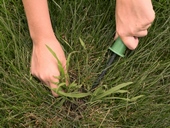FOR IMMEDIATE RELEASE
ACS News Service Weekly PressPac: June 26, 2013
Crabgrass’ secret: The despised weed makes herbicide to kill neighboring plants
“Crabgrass (Digitaria sanguinalis) Allelochemicals That Interfere with Crop Growth and the Soil Microbial Community”
Journal of Agricultural and Food Chemistry
Contrary to popular belief, crabgrass does not thrive in lawns, gardens and farm fields by simply crowding out other plants. A new study in ACS’ Journal of Agricultural and Food Chemistry has found that the much-despised weed actually produces its own herbicides that kill nearby plants.
Chui-Hua Kong and colleagues point out that crabgrass is not only a headache for lawns and home gardens, but also a major cause of crop loss on farms. Scientists long suspected, but had a hard time proving, that the weed thrived by allelopathy. From the Greek “allelo-,” meaning “other,” and “-pathy,” meaning “suffering,” allelopathy occurs when one plant restricts the growth of another by releasing toxins. They set out to determine if crabgrass has this oppressive ability.
Kong’s team isolated three chemicals from crabgrass that affect the microbial communities in nearby soil and did indeed inhibit the growth of staple crops wheat, corn and soybeans. “The chemical-specific changes in [the] soil microbial community generated a negative feedback on crop growth,” the scientists said, noting that the chemicals also would have a direct toxic effect on other plants.
The authors acknowledge funding from the National Natural Science Foundation of China.
Contact
Science Inquiries: Michael Woods, Editor, 202-872-6293
General Inquiries: Michael Bernstein, 202-872-6042


